Book contents
- Frontmatter
- Contents
- List of illustrations
- List of tables
- List of contributors
- Acknowledgements
- Foreword by Klaus Toepfer
- Introduction
- Part I General principles
- Part II The legal framework
- Part III Assessing the impacts – scientific methods and issues
- Introduction
- 11 Scientific assessment of the long-term environmental consequences of war
- 12 The Gulf War impact on the terrestrial environment of Kuwait: an overview
- 13 War-related damage to the marine environment in the ROPME Sea Area
- 14 War and biodiversity: an assessment of impacts
- Introduction
- 15 Tracking the four horsemen: the public health approach to the impact of war and war-induced environmental destruction in the twentieth century
- 16 Defoliants: the long-term health implications
- 17 The impact of military preparedness and militarism on health and the environment
- 18 War and infectious diseases: international law and the public health consequences of armed conflict
- Part IV Valuing the impacts – economic methods and issues
- Part V Prospects for the future
- Index
13 - War-related damage to the marine environment in the ROPME Sea Area
Published online by Cambridge University Press: 04 August 2010
- Frontmatter
- Contents
- List of illustrations
- List of tables
- List of contributors
- Acknowledgements
- Foreword by Klaus Toepfer
- Introduction
- Part I General principles
- Part II The legal framework
- Part III Assessing the impacts – scientific methods and issues
- Introduction
- 11 Scientific assessment of the long-term environmental consequences of war
- 12 The Gulf War impact on the terrestrial environment of Kuwait: an overview
- 13 War-related damage to the marine environment in the ROPME Sea Area
- 14 War and biodiversity: an assessment of impacts
- Introduction
- 15 Tracking the four horsemen: the public health approach to the impact of war and war-induced environmental destruction in the twentieth century
- 16 Defoliants: the long-term health implications
- 17 The impact of military preparedness and militarism on health and the environment
- 18 War and infectious diseases: international law and the public health consequences of armed conflict
- Part IV Valuing the impacts – economic methods and issues
- Part V Prospects for the future
- Index
Summary
Introduction
BACKGROUND
The Arabian or Persian Gulf forms an arm of the Indian Ocean extending into the Arabian Peninsula, an area that constitutes the inner part of the Regional Organization for the Protection of the Marine Environment (ROPME) Sea Area – the “RSA.” This new term was coined to achieve unanimity in signing the 1978 Kuwait Regional Convention for Cooperation on the Protection of the Marine Environment from Pollution. The ROPME Sea Area also includes the Gulf of Oman and the Iranian and Omani waters of the Arabian Sea. This chapter uses the terms “Gulf” and “ROPME Sea Area,” or “RSA,” interchangeably.
The ROPME Sea Area is a relatively small, flooded valley-estuary with a surface area of 240,000 km2. It is approximately 1,000 km in length and 200–300 km in width, narrowing to only 54 km at the Strait of Hormuz. It is generally shallow, mostly less than 60 m deep, with an average depth of 35 m, but increasing to 100 m near the Strait of Hormuz. The western part of the RSA is very shallow (less than 5 m), with tidal flats extending up to 5 km. The bottom topography is generally featureless with mostly soft sediments. It is muddy in the northern and northwestern parts and sandy along the southern section, reflecting the largely biogenic origin of sediments in the area (Figure 13.1).
The intense sunlight and shallowness of the water makes the RSA highly productive, which has encouraged the establishment of well-developed shrimp and fin-fish fisheries in the area.
- Type
- Chapter
- Information
- The Environmental Consequences of WarLegal, Economic, and Scientific Perspectives, pp. 338 - 352Publisher: Cambridge University PressPrint publication year: 2000
- 2
- Cited by



